Somalia. A fragile equilibrium.
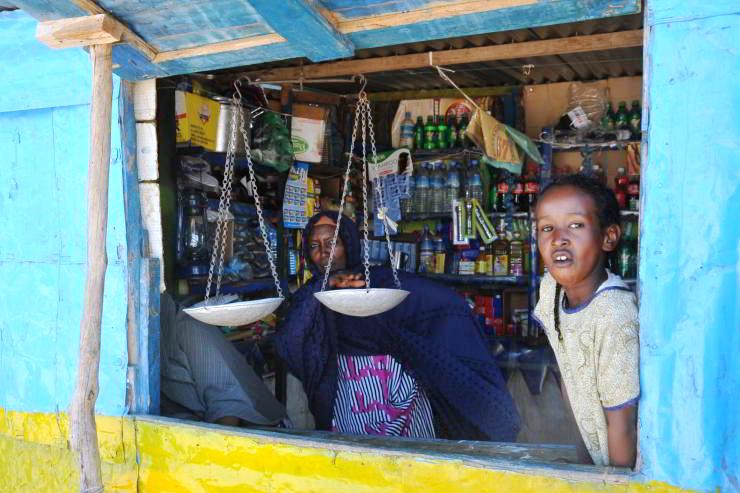
After fifty-six years, Somalia returns to the polls. In June for local elections and in September for legislative elections. Many challenges. The Somaliland issue.
Somalia is still one of the poorest countries in the world and the impact of drought, plagues, conflicts and volatile world prices directly affects its economic development. According to the World Bank, the salary of two-thirds of the population is 2.15 dollars a day. It is estimated that 54% of the population lives below the poverty line, a much higher percentage among nomadic communities.
In addition, the workforce is minimal: 33% of men and only 12% of women. Despite this, there has been a consolidation of the economic turnaround in recent years, particularly evident in the capital Mogadishu. In 2024, the country managed to emerge from a situation of over-indebtedness, favouring the arrival of new investments and the promotion of social structures such as Baxnaano, the first national social protection program. Moreover, the latest news about oil exploration off the coast of Somalia has attracted the attention of large international companies. It remains to be seen what the effects of this future exploitation will be on the environment and, in particular, on the coasts. All this economic development would not have been possible without the political stabilization of the country.
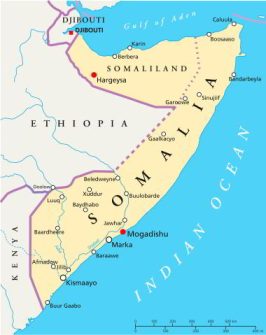
Somalia Political Map. 123rf
Despite numerous adversities, the situation has been improving since 2012. The Federal Government of Somalia (FGS) controls much of the south and centre of the country, where it has established an administration and has managed to reduce the influence of the terrorist group Al-Shabaab, which in 2011 dominated significant areas in the south of the country.Besides, since 2013, the different federal regions of Somalia have been formed, which have been the cornerstone of the expansion of the State. Today, Somalia is composed of seven regions and the capital, although Somaliland remains a de facto independent state. Relations between the state and some regions have been tense, especially with Jubaland and Puntland, which in 2021, after extending his presidential mandate, came into conflict with former Prime Minister Mohamed Abdullahi, known as Farmajo. These regions have their main supporters in two neighbouring states: Ethiopia and Kenya. Meanwhile, the Southwest, Hirshabelle and Galmudug regions are the main pillars of the central government.
Election time
This year, Somalia will hold elections for municipal councils this month of June, while representatives of the Federal Parliament, members of state legislatures and presidents will be elected in September. This is one of the country’s major challenges, as it has not held universal suffrage elections since 1969.
The debate has been ongoing for years: in each legislature, presidents commit to promising that the next elections will be held with the “one person, one vote” system, but this has never been respected. Currently, the parliamentary election system involves the selection of delegates, elected by each of the clans that make up Somalia.
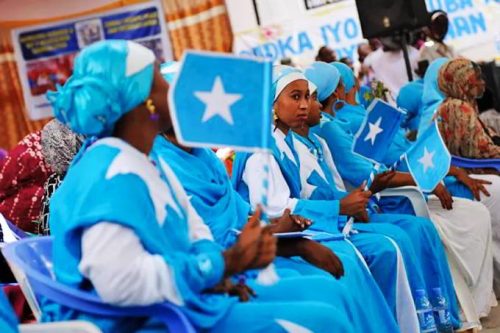
Year of elections in Somalia. In June, for municipal councils this month and in September, for the representatives of the Federal Parliament. Phil Moore/IRIN
These delegates in turn elect the deputies who will vote for the President. Although there has been an official register of political parties since 2017, they are not very widespread, mainly because they have not been active in the country’s political life. In addition, it is often reported as another problem that there are regions where it will not be possible to vote due to the threat of Al-Shabaab. In the meantime, some progress has been made. On November 27, 2024, the Somali Parliament approved the creation of the new Federal Election Commission. The vote took place one day after the executive had approved the creation of the body.
The great challenge
Despite a certain stability within the country and the creation of a government with greater capacity for action, the Federal Republic of Somalia still faces a territorial challenge: one of its regions acts as an independent state. In 1991, Somaliland, in the far north, unilaterally declared its independence and built its own state, becoming one of the most stable regions in the Horn of Africa. Although not recognized internationally, Somaliland has a constitution, a government, its own currency and an army that defends its sovereignty.
Despite negotiations, it was impossible to reach an agreement, as the starting points are radically different: for Somalia, it is just another territory of the Republic; Somaliland, on the other hand, considers itself a legitimate independent state.
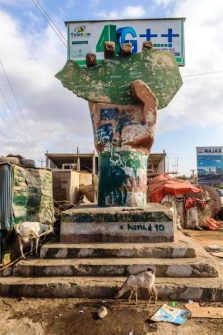
Somaliland Independence Monument in Hargeisa, capital of Somaliland. 123rf
Somaliland considers its official borders to be those of its colonial past: its borders are those of the former British protectorate of the same name. However, the eastern provinces of Sool, Sanaag and Cayn are inhabited by a majority of Dulbahaante and Warsangali Somalis who, for years, have felt marginalized by the central government of Somaliland and its majority population, the Isaaq. The first two groups are more closely linked to the Puntland populations, with whom they share the same branch of the Darood clan. In these circumstances, Puntland and Somaliland have clashed on several occasions for control of these territories.
In January 2023, the situation reversed with the start of the so-called ‘Blue Revolution’, a reference to the blue of the Somali national flag. Public demonstrations on the main streets of cities, especially in Las Anod, the administrative capital of the Sool region, prompted the government of Mogadishu to intervene to increase its presence in the area. The unrest has led to a new confrontation, with the military penetration of Somaliland into the region to reassert control over the territory. However, its troops were expelled in the summer of 2023 and effective control of these provinces is very limited.
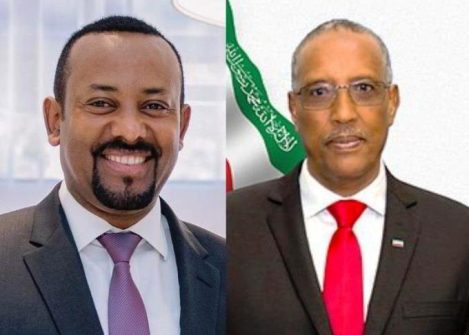
The prime minister of Ethiopia, Abiy Ahmed and Muse Bihi Abdi, the president of SomalilandOffice of the Prime Minister – Ethiopia – Madaxtooyada JSL
In this situation, Mogadishu proclaimed the creation of the federal state SSC-Khatumo. The acronym is composed of the initials of the three provinces in question, while khatumo can be translated as “positive result”. This move by the federal government has generated unrest in both Puntland and Somaliland. The former believed that this was a territory that should be part of their federal state, while the latter argued that it was an inalienable part of their territory. The result so far has undoubtedly been very positive for Mogadishu, which has not only expanded its sphere of influence, controlling territories that were under the administration of Somaliland but has also managed to curb the aspirations of Puntland, which is one of the largest and most powerful states in Somalia.
A Complex Network
While Somalia is achieving significant successes domestically, the situation on the international scene is rather agitated. Relations with its neighbours have been characterized by continuous disagreements and military invasions, especially by Ethiopia, but also by Kenya. The governments of Addis Ababa and Nairobi have acted in Somali territory to protect their own interests and security and have maintained close relations with Somaliland.
Tensions have been increased by Ethiopia’s decision to sign a Memorandum of Understanding (MoU) with Somaliland in early 2024, which implied the Ethiopian government’s commitment to recognize Somaliland as a state in exchange for the transfer of a coastal territory for the construction of a port that would give Ethiopia its long-awaited access to the sea.
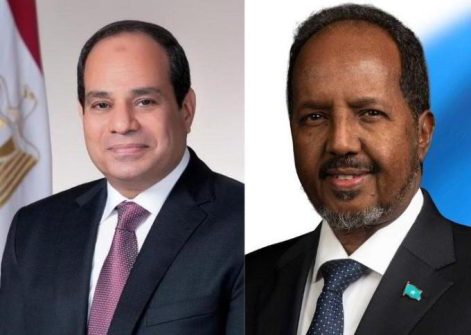
Egyptian President Abdel Fattah El-Sisi and Somali President Hassan Sheikh Mohamud. Office of the president
Mogadishu sees the agreement as a direct aggression. At the same time, the MoU itself has generated great confusion. Addis Ababa intends that the territory be ceded for an indefinite period, while Hargeisa speaks only of an agreement to build a military port in the area. In addition, the signing of the agreement has strengthened regional alliances between Eritrea and Somalia, territories that are under pressure from the Ethiopian threat to obtain a commercial port. They have been joined by Egypt, a traditional ally that defends its territorial integrity and sovereignty. Thus, in 2024, the three countries reaffirmed their mutual cooperation and Al Sisi’s government has committed to sending troops to Somalia to help stabilize it and fight against Al-Shabaab. This development, together with the statements of Somali President Hassan Sheik Mohamud, in which he assured that the government will decide which troops remain in Somali territory, has generated some uncertainty in the Ethiopian army. Addis Ababa was the main contributor to ATMIS (African Transition Mission in Somalia), but due to enmity between Ethiopia and Somalia, its departure seems likely with the launch of the new AUSSOM mission. Relations with its other neighbour, Kenya, have also not been cordial. Its Kenyan government has seen the Somali border as a security issue, stemming from Somali refugee and migration pressure and the threat posed to the country by Al-Shabaab. The terrorist attacks at Nairobi’s Westgate in 2013, with 72 deaths, and at Garissa University in 2015, with 147 deaths, have strengthened Kenya’s position. In addition to tense relations with the Somali government, it has unilaterally intervened militarily and extended its influence over Jubaland, of which it has become the main ally, strengthening its role as an opponent to Mogadishu. This relationship has had a domestic fallout.
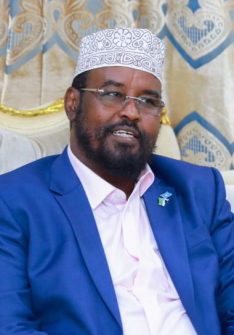
President of Jubaland, Ahmed Mohamed Islam Madobe. Photo: Gov.Somalia
On November 25, Ahmed Madobe, who has led the federal state since 2012, was re-elected president of Jubaland. His election was declared illegal by Somalia, which led to some regional revolts. Relations between the two administrations have always been complex, partly due to the influence of neighbouring Kenya. Finally, Kenya’s rapprochement with Somaliland led to the breakdown of relations with Somalia in 2020, further aggravating the situation. Al-Shabaab has been the main actor opposing the Somali government since 2007. Heir to the Islamic Courts Union, it has radicalised and controlled large areas of southern Somalia, including Mogadishu, until 2011, when it was expelled. Although its territorial presence has decreased year after year, it has not meant the end of acts of violence, which have increased. In October 2017, it committed the worst terrorist attack in the history of Somalia and the second worst in the world in terms of number of victims, only after 9/11. The explosion of a tanker in the capital caused more than 600 deaths. The most immediate effect was the reaction of the population, a part of which had legitimized and supported their actions. Today, the terrorist group continues to lose ground, but the challenge for the government is to contain the terrorist attacks and eliminate the main destabilizing element within the country. In recent years, Somalia has made progress towards economic and political stabilization, reaching a very fragile balance that is at risk without international action. The stability of Somalia depends on regional relations based on cooperation with neighbouring states and on a lasting peace. (Open Photo: Shutterstock/Free Wind)
Pablo Arconada Ledesma



